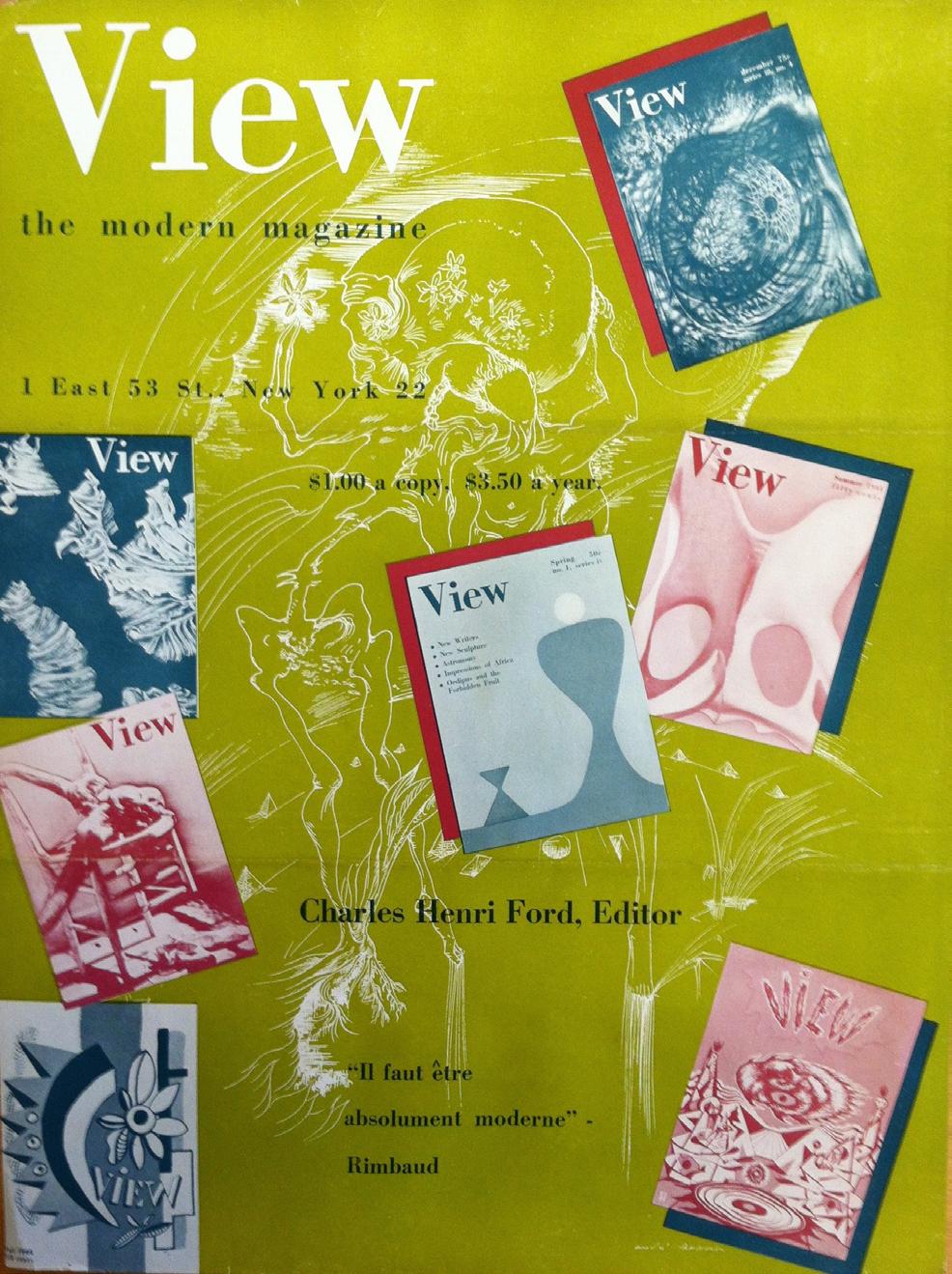
9 minute read
OTHER POINTS OF VIEW Text by Tirza True Latimer
Other Points
The art journal View, edited by Charles Henri Ford and Parker Tyler from 1940 to 1947, highlighted vibrant cultural enterprises that escape notice in formalist taxonomies of modern art. For the first half of the twentieth century, the so-called American Century, when distilling the unique characteristics of American modernism preoccupied influential art-world figures from Alfred Stieglitz and his circle to the critic Clement Greenberg, View examined cultural life in the Americas from divergent perspectives. 1 Bringing together surrealists, magic realists, neo-romantics, and self-taught artists from Europe and the Americas, View cultivated alternative understandings of both the qualifier “American” and the term “modernism.” of Text by Tirza True Latimer View
Advertisement
1 Henry Luce, creator of the Time-Life publishing empire, in his editorial for Life, February 17, 1941, declared that the twentieth-century must be, “to a significant degree, an American Century.”
View contributors bucked prevailing professional trends by working collaboratively in such arenas as opera, ballet, and theater. Instead of making claims about art’s “autonomy” (its absolute independence from the social contexts of its production) they explored art’s implication in modern social and sexual relations. Rather than espousing notions of medium-specific purity, they privileged interdisciplinary and hybrid genres. And, at a time of heightened nationalism, they devoted much of their creative energy to sustaining affiliations across territorial boundaries.
The exhibition looks the mid-twentieth-century artistic scene in America through the lens of View magazine, re-introducing queer artists and critics—foremost Charles Henri Ford (1908-2012), Parker Tyler (1904-1974), and Pavel Tchelitchew (1898-1957)—who had a significant impact on modern art in America between the two World Wars, but then disappeared from its history. At the same time, the exhibition recontextualizes (and reawakens the strangeness of) certain modernists now considered canonical. These modernists include Joseph Cornell (1903-1972), who created a wrap-around cover for the January 1943 issue of View; Alexander Calder (1898-1976), whose work appears on the cover in Spring 1944; Georgia O’Keeffe (1887-1986), whose painting was reproduced on the cover of the Summer 1944 issue; and Isamu Noguchi (1904-1988) whose sketch for the cover of the October 1946 issue is displayed in the exhibition.
The exhibition is distinctive in that it places emphasis on ephemeral objects and events, alongside fine art objects, to show modernism from unaccustomed angles. While restoring View magazine to a place of prominence among mid-century journals of art and criticism, Other Points of View also spotlights some of the theatrical initiatives that gave the magazine’s contributors their first opportunities for creative collaboration in the United States. The opera Four Saints in Three Acts, with libretto by Gertrude Stein, score by Virgil Thomson, choreography by Frederick Ashton, décor by Florine Stettheimer, and an all African American chorus directed by Eva Jessye, set the stage for subsequent group endeavors. The opera premiered at the Wadsworth
Fig. 1
2 Charles Henri Ford, letter to subscribers dated 3 April 1947. YCAL MSS 32, box 4, Beinecke Rare Books and Manuscript Collection, Yale University.
3 Mark Polizzotti, Revolution of the Mind: The Life of André Breton (New York: Farrar, Straus and Giroux, 1995): 508. Thank you, Michael Taylor.
4 Greenberg’s essay “‘American-Type’ Painting,” published in the Partisan Review in 1955, emphasizes the national specificity of noteworthy contemporary artistic practices, specifically color field painting. Greenberg elaborated the development of modern art in terms of purity (the elimination of extraneous or “literary” content) and pictorial flatness.
5 In the Partisan Review article “The Renaissance of the Little
Mag,” Greenberg characterized the editors of View as an “American species” of surrealist that “identifies literature and art with its social life.” Clement Greenberg, “The Renaissance of the Little Mag,” Partisan Review 7:1 (January-February 1941): 73.
Atheneum Museum of Art in Hartford, Connecticut, in 1934. Two years later, the Wadsworth hosted The Paper Ball, a masquerade extravaganza staged in the museum’s atrium, which Tchelitchew had festooned with a three-story cut-paper décor. By paying serious attention to social life, collaboration, and ephemeral practices dismissed as eccentric distractions in their day, Other Points of View restores diversity—including, impor tantly, queerness—to the field of American art.
View helped to form modernism’s queer matrix. “View’s unique contribution,” Ford explained to potential backers in a fundraising letter, “is to give voice to cultural manifestations…not necessarily falling within prescribed modern styles and forms, but always expressing ideas that are vital and out-of-the-ordinary.” 2 What did out-of-the-ordinary mean to Ford? The covers and contents of View, compared to other publications produced in the U.S. during an era of escalating nationalist fervor, seem to anticipate a label viciously deployed by Senator Joseph McCarthy (in office 1947-1957) only a few years later to stigmatize and censure all manner of diversity, any deviation from the norm, as “un-American.”
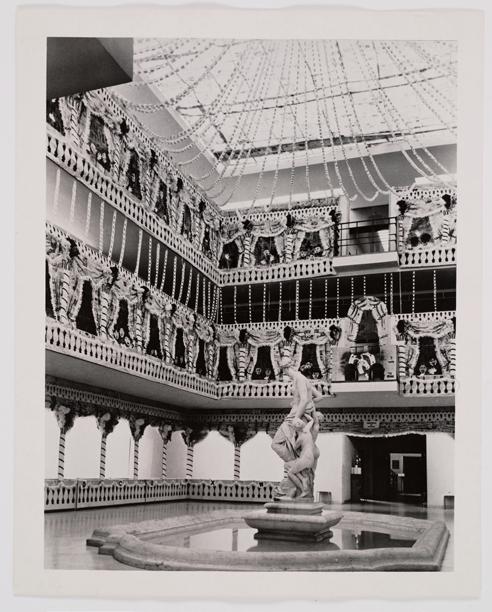
According to the surrealist leader André Breton, exiled in New York during the 1940s, View was nothing more than a showcase for cosmopolitan queers—or, as Breton put it, “pederasty international.” 3 Yes, many of the contributors to View were gay. But just as many were not. Was there more political intentionality behind View magazine’s extra-ordinary-ness than Breton was willing or able to admit? As contemporary viewers, looking back, it is clear that the journal doesn’t jibe with the progress narrative of modernism espoused by Clement Greenberg. But could View’s commitment to the out-of-the-ordinary be understood as a mode of resistance to the era’s narrowing notions of modernism and American-ness?
Presenting ill-assorted work by aliens, misfits, immigrants, itinerants, conscientious objectors, autodidacts, free thinkers, and sexual outlaws, View magazine represented both America and modernism as spaces of possibility for social outcasts, eccentrics, and resisters of artistic norms, and discrepant cultural discourses. Looking at View reveals an unfamiliar, highly unstable, and exceptionally diverse modernist landscape that does not conform to the art historical narratives we have inherited.
By collaborating across various kinds of boundaries, the artists associated with View openly acknowledged the importance in their development of social networks. This at a time when rugged individualism accrued value as a particularly American attribute and Greenberg—with his essay “‘American-Type’ Painting” among other writings—shaped new discourses of American modernism based on values that View contested. 4
View was, for Greenberg, anathema. You could say he formulated his thoughts about modernism ‘against’ View and all that the magazine represented. He complained that for the View milieu art was merely a backdrop for their social (and sexual) lives. 5 While the editors of View never proselytized about their political beliefs or social values (which included homophilia, anti-racism, and sex-positivity), they facilitated and benefited from transactions in the cultural arena that relied on and reinforced their sexual-social connections, and made them quite apparent to those in the know. Neither Charles Henri Ford nor Parker Tyler would have contradicted Greenberg’s critique that View identified art with social life.
Indeed, contre Greenberg, View saw sociability as one of the magazine’s great strengths. View labored to create a social space of intellectual and artistic exchange for contributors and readers alike. The quarterly publication was only one of a number of related View enterprises. View published books under its imprimatur, including a bi-lingual edition of André Breton’s Young Cherry Trees Secured Against Hares (1947). View hosted small exhibitions in the magazine’s midtown offices and also partnered with Julien Levy Gallery and Hugo Gallery to present work by artists View featured in its issues. Ford and Tyler were among the first to throw lavish opening parties in New York galleries, complete with flower arrangements and champagne. In a few
Fig. 3
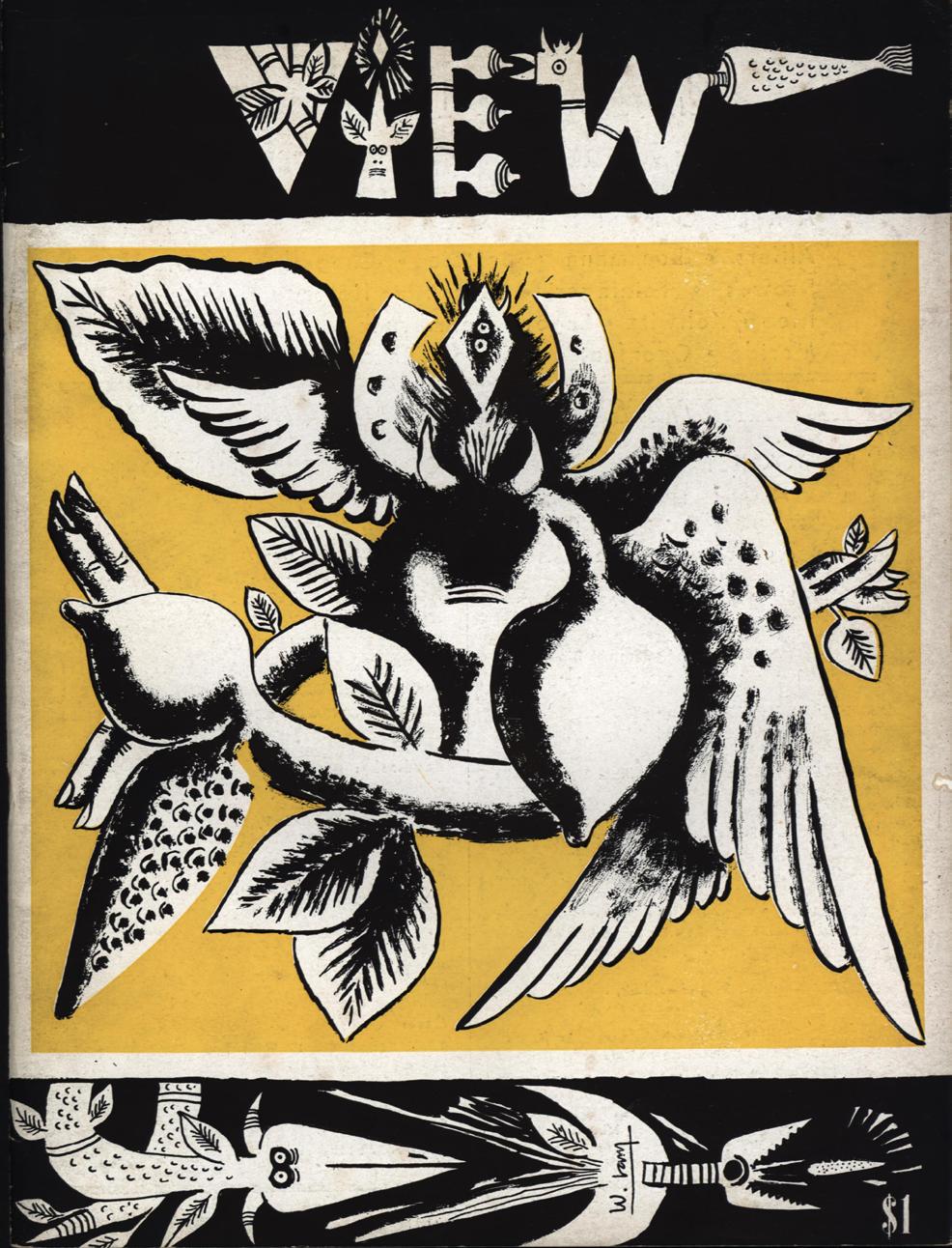
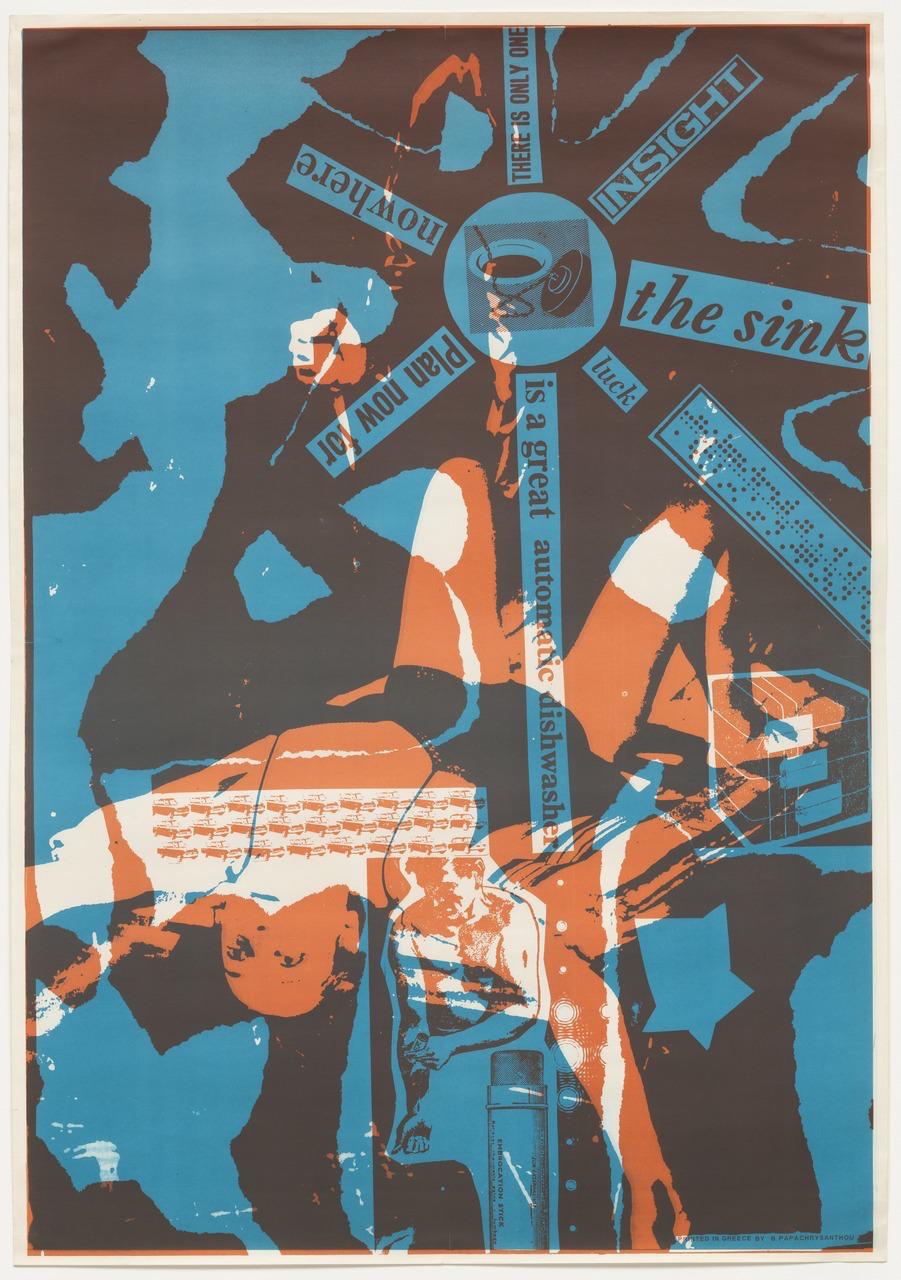
Fig. 5
6 The release of View’s May 1942
“Tchelitchew Issue,” for instance, coincided with a Tchelitchew retrospective at Julien Levy Gallery; a display ad for the show appeared on page one of the magazine.
7 The 2001 documentary Sleep in
a Nest of Flames, Symbiosis Films (James Dowell and John Kolomvakis) features a contemporary reconstruction of Ford’s surrealist puppet play, A Sentimental Playlet, with music by Paul Bowles. The original puppets were designed by the Swiss Surrealist artist Kurt Seligmann (1900-1962) and his spouse Arlette Seligmann (1906-1992). The play premiered at Spivy’s Roof nightclub in New York City, in June of 1946.
8 Clement Greenberg, “The Renais
sance of the Little Mag,” Partisan Review 7:1 (January-February 1941): 73.
9 Clement Greenberg, “The Renais
sance of the Little Mag,” 74.
10 Charles Henri Ford, interview by
Bruce Wolmer, Bomb 18 (Winter 1987) http://bombsite.com/issues/18/articles/868 (accessed 6/9/13).
11 See Parker Tyler, Screening the
Sexes: Homosexuality in the Movies (New York: Holt, Rinehart, and Winston, 1972).
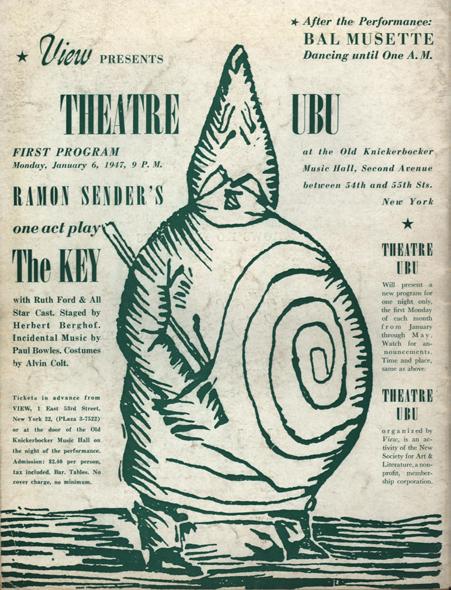
instances, issues of View doubled as catalogues for these shows, with Parker Tyler generating critical texts. 6 View also sponsored Jazz concerts and lectures (including one by Jean-Paul Sartre at Carnegie Hall), and organized experimental theatrical performances. 7 View co-founded the off-Broadway Theatre Ubu, where Charles Henri Ford’s sister, Ruth Ford, starred. View reported on and advertised these events, which were often highlights of New York Bohemia’s social season, thus expanding the lively boundaries of the magazine.
But in Greenberg’s estimation, View’s imbrication in social life trivialized the artistic vocation. “This social life is complicated and satisfying,” he quipped. “The gossip is good if you know the names; if you know the people I imagine it might get to be a little too much.” 8 Greenberg concluded his coverage of View in a review titled “The Renaissance of the Little Mag” with the over-zealous declaration, “I am for the extinction of the milieu.” 9 Does homophobia alone account for the violence of Greenberg’s attack? Or was he, perhaps, threatened by the alternatives of modern creative practice that View modeled with its ebullient eclecticism?
Against the backdrop of Greenbergian formalism, the eccentric modernists spotlighted in View stood apart. They built practices and sustained relationships based on affinities not defined in nationalist or formalist terms. They did not participate in the progress narrative that defined modern art as a long arc toward abstraction, beginning in Paris at the dawn of the twentieth century and reaching an apogee in New York in the wake of America’s Second-World-War victory. The artistic alliances loosely binding View’s artists together formed, instead, around resistance to categorization, convention, and normativity. Their kinship was based on affection (and often desire) for one another, as well as a commonly espoused solidarity with all manner of queers and misfits.
Throughout the 1940s, View magazine vied with and responded to such influential journals as the Partisan Review, where Greenberg’s criticism appeared, and Breton’s “official” surrealist magazine VVV. Yet by the 1950s View had vanished, leaving behind barely a trace on the historical record. View’s “war work,” as Ford described it, effectively ended with the shutdown of View in 1947. 10 A cultural war in the U.S. had begun, however, and this was not a war that the View milieu could win at that time.
The exhibition Other Points of View traces not only the lineage of the View enterprise (its debt to Gertrude Stein’s generation) but also its legacy. Charles Henri Ford’s Poem Poster series from the 1960s and Parker Tyler’s writings on homosexuality in cinema from the early 1970s lent further impetus to a cultural trajectory that such artists as Andy Warhol (1928-1987) and Jack Smith (1932-1989) made even more visible. 11 Other Points of View at Leslie-Lohman Museum sheds light on this queer history of modern and contemporary art.
OTHER POINTS OF VIEW On View: February 8 – May 17, 2020 Curated by Tirza True Latimer
Tirza True Latimer, Professor of Visual Studies, California College of the Arts, is author of Eccentric Modernisms: Making Differences in the History of American Art (2016).










